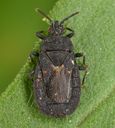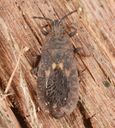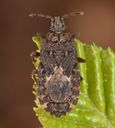Mezirinae
Mezirinae
Classification
- Phylum: Arthropoda
- Subphylum: Hexapoda
- Class: Insecta
- Order: Hemiptera
- Suborder: Heteroptera
- Infraorder: Pentatomomorpha
- Family: Aradidae
- Subfamily: Mezirinae
Pronunciation
How to pronounce Mezirinae: /mɛzɪrˈiːnae/
These audio files are automatically generated. While they are not always 100% accurate, they are a good starting point.
Images






Summary
Mezirinae is a diverse subfamily of flat bugs, characterized by more than 1120 species worldwide, predominantly found in tropical regions, and plays a role in plant ecology as herbivores.
Physical Characteristics
Flat-bodied insects with a diverse range of shapes and sizes due to extensive speciation.
Identification Tips
Identification can be based on the specific shape of the body and the presence of distinct markings or coloration unique to certain species.
Habitat
Primarily tropical regions of the Southern Hemisphere, with some species found in temperate regions.
Distribution
Globally, with a higher diversity in tropical regions; in temperate areas, diversity reduces with only a few species occurring in the Holarctic, and more diversity found in southern regions.
Diet
Herbivorous, feeding on plant sap or other plant materials.
Life Cycle
Life cycles typical of Hemiptera, consisting of egg, nymph, and adult stages.
Reproduction
Reproduction through sexual means, involving the laying of eggs that hatch into nymphs.
Ecosystem Role
Part of the ecological food web, serving both as herbivores and as prey for various predators.
Collecting Methods
- Light traps
- Sweep nets
- Hand collecting
Preservation Methods
- Ethanol preservation
- Drying specimens
- Pinning in entomological collections
Evolution
Evolutionary history includes a significant radiation into diverse forms adapted to various ecological niches, particularly in tropical environments.
Similar Taxa
Misconceptions
Often mistaken for other hemipterans due to superficial similarities.
Tags
- Entomology
- Hemiptera
- Biodiversity
- Tropical Insects